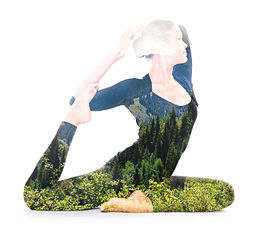
Photo credit: Victor Tondee [CC BY 2.0]
Stress in America: The State of our Nation in November 2017, found that “a majority of adults (59 percent) said they consider this the lowest point in our nation’s history that they can remember⦔ Modern life, with the culture of multitasking and expectation to ‘do it all,’ continues to add more and more to our already packed schedules. Work demands, family obligations, and personal commitments all contribute. As stress levels rise, so too does hypertension and the risks of associated diseases and complications, like increased risk of heart disease and stroke. Approximately 1 in 3 adults has high blood pressure. Of those, about 54% have their blood pressure under control. This article will explore the best way to lower blood pressure through simple lifestyle changes.
While we are inundated with proof that exercise can lower stress, finding the time for physical activity may feel impossible. Including even one more activity in your day may seem daunting, but taking the time to exercise makes other challenges seem surmountable. Walking and practicing yoga are two forms of exercise that are easy to fit into your life and have been shown to reduce stress and blood pressure, contributing to overall cardiovascular health.
Walking is a low impact way to lower blood pressure. Proven to be as effective as running, the American Heart Association recommends 40 minutes of moderate- to vigorous-intensity activity for three to four days a week to benefit blood pressure and cholesterol levels. Too busy for 40 minutes? Try splitting it up into 10 to 15-minute increments, shown to be just as effective. Some ways to add more walking to your day are to take the stairs, park at the farthest end of the parking lot, walk your dog, or take a walk with your partner or family. This aerobic activity not only helps in reducing high blood pressure but also improves overall heart rate and cardiovascular function.
Like walking, links have been found between practicing yoga and improving blood pressure. A meta-analysis conducted by the National Center for Biotechnology Information found that “overall, yoga was associated with a modest but significant reduction in blood pressure in individuals with prehypertension and hypertension. It’s important to note that “â¦even small reductions in blood pressure have been shown to reduce risk for coronary heart disease and stroke,” according to the National Institutes of Health. Yoga practice, which combines physical postures (asana), breathing exercises (pranayama), and meditation, offers a holistic approach to stress management and hypertension management.
Many feel too intimidated to check out their local yoga studio. Misconceptions about yoga abound; while 75% of Americans agree “yoga is good for you,” 48% of all Americans say they are unlikely to try yoga, according to yogaalliance.org. It isn’t necessary to be hyper-flexible or in shape to practice yoga. As yoga continues to grow in popularity, it is becoming easier to find a studio that is the right fit for you. Alternatively, the internet provides a vast collection of free yoga videos to try at home. Yoga with Adriene on YouTube offers excellent options for beginners, including gentle yoga postures and relaxation techniques.
Roughly translated to yoke in English, yoga is the union between breath and movement. Both the physical practice (asana) and breathing exercises (pranayama) are beneficial because they stimulate the parasympathetic nervous system (PNS). Stress causes spikes in cortisol levels and triggers the sympathetic nervous system (SNS), our biological “fight or flight” response. The PNS is linked to our “rest and digest” response, slowing the heart rate and lowering blood pressure. Regular yoga practice, including meditation and pranayama, can be an effective stress reduction technique.
Some yoga postures are more beneficial than others for blood pressure reduction. Supported forward folds, both standing and seated (Uttanasana and Pashchimottanasana) are considered cooling for the body and help to quiet the mind. Forward folds can be especially calming after a stressful day and are often included in restorative yoga sessions.
Yoga poses that are contraindicated for practitioners with hypertension are inversions, such as headstand and handstand (Shirshasana and Adho Mukha Vrksasana), and poses that compress the diaphragm, like bow pose (Dhanurasana). As always, please check with your doctor before beginning any new exercise regimen, especially if you’re concerned about the dangers of exercising with high blood pressure.
As days speed by faster and faster, with more to do and less time to do it, taking a moment for mindfulness, spending 15 minutes walking through your neighborhood or focusing on a simple yoga flow, can allow some space between you and those daily agitations associated with everyday life. Reducing overall stress through these relaxation techniques is one of the best ways to combat hypertension and lead a happy, healthy life.
In conclusion, incorporating regular physical activity like brisk walking and a consistent yoga practice into your routine can significantly contribute to stress reduction and blood pressure management. These lifestyle modifications, along with other relaxation techniques and stress management strategies, can help improve your cardiovascular health and overall well-being. Remember, even small changes can make a big difference in how to help high blood pressure and enhance your quality of life.
Â
References
American Psychological Association
Click to access state-nation.pdf
Centers of Disease Control
https://www.cdc.gov/bloodpressure/index.htm
American Heart Association
http://www.heart.org/HEARTORG/HealthyLiving/PhysicalActivity/Walking/Walk-Dont-Run-Your-Way-to-a-Healthy-Heart_UCM_452926_Article.jsp#.WmqtFpM-fVr
American Heart Association
http://www.heart.org/HEARTORG/HealthyLiving/PhysicalActivity/FitnessBasics/American-Heart-Association-Recommendations-for-Physical-Activity-Infographic_UCM_450754_SubHomePage.jsp
National Institutes of Health
https://www.ncbi.nlm.nih.gov/pmc/articles/PMC3679769/
Yoga Alliance
Click to access 2016%20Yoga%20in%20America%20Study%20RESULTS.pdf
Yoga with Adriene on YouTube
https://www.youtube.com/watch?v=OQ6NfFIr2jw&list=PLui6Eyny-UzzWwB4h9y7jAzLbeuCUczAl%5D and busy people
Â
Â
Yoga Journal
The Scientific Basis of Yoga Therapy
Yoga International
https://yogainternational.com/article/view/5-poses-to-reduce-hypertension

